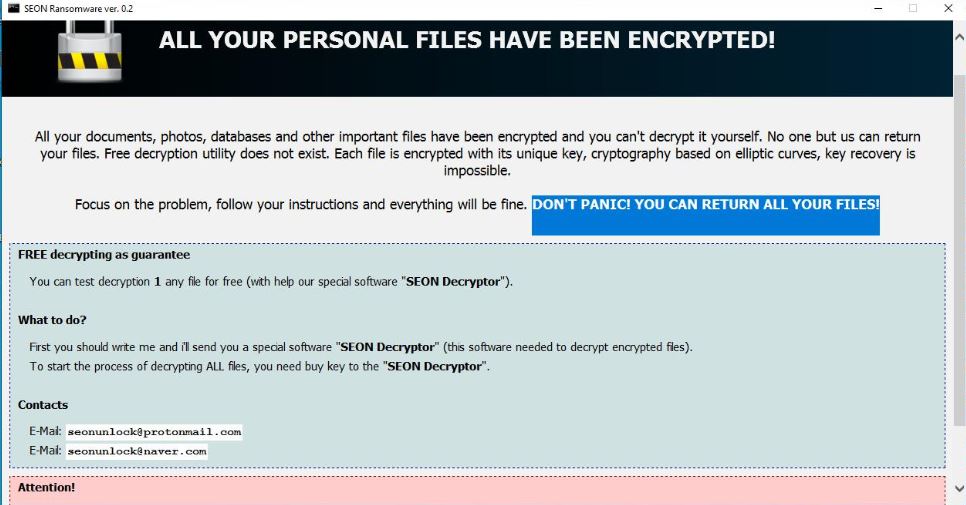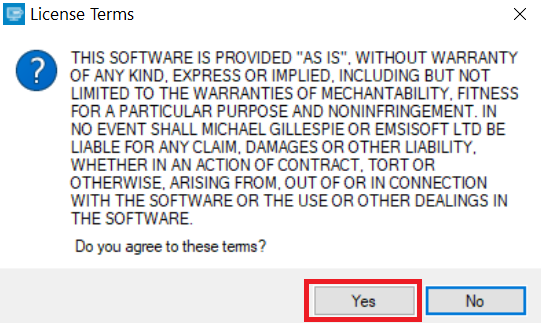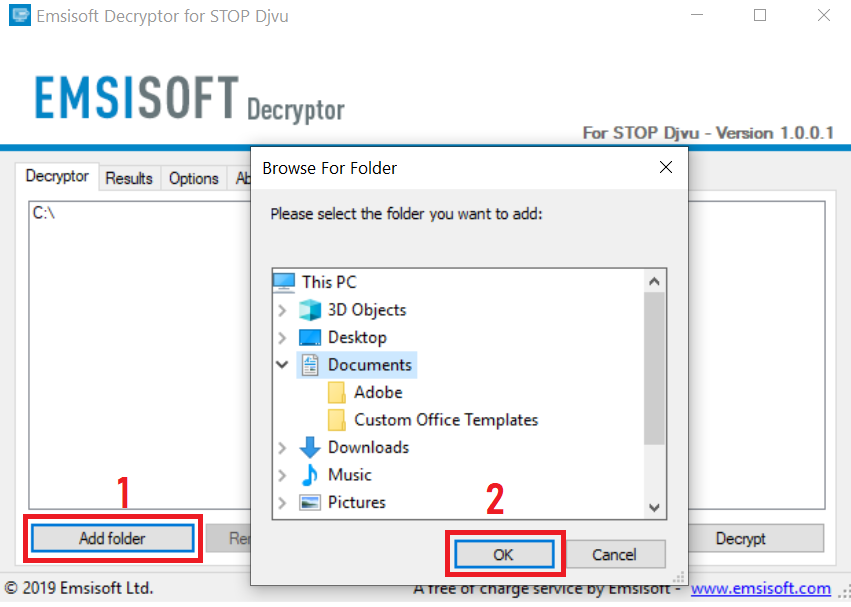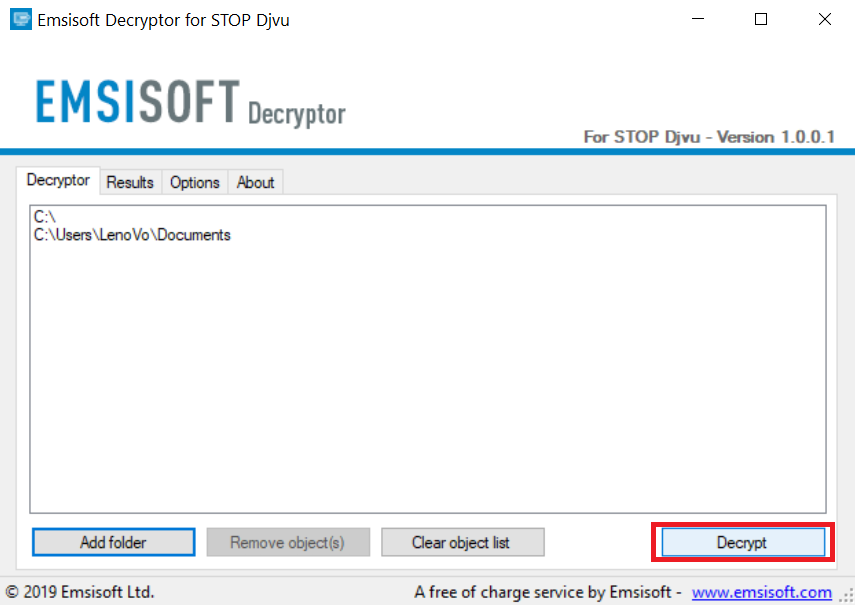SIDENOTE: This post was originally published in November 2018.
This article will aid you to remove Seon Virus. Follow the ransomware removal instructions provided at the end of the article.
Seon Virus is one that encrypts your data and demands money as a ransom to get it restored. Files will receive the .FIXT extension. The Seon Virus will leave ransomware instructions as a desktop wallpaper image. Keep on reading the article and see how you could try to potentially recover some of your locked files and data.

Threat Summary
| Name | Seon virus |
| Type | Ransomware, Cryptovirus |
| Short Description | The ransomware encrypts files by placing the .FIXT before the affected files on your computer system and demands a ransom to be paid to allegedly recover them. |
| Symptoms | The ransomware will encrypt your files and leave a ransom note with payment instructions. |
| Distribution Method | Spam Emails, Email Attachments |
| Detection Tool |
See If Your System Has Been Affected by malware
Download
Malware Removal Tool
|
User Experience | Join Our Forum to Discuss Seon virus. |
| Data Recovery Tool | Windows Data Recovery by Stellar Phoenix Notice! This product scans your drive sectors to recover lost files and it may not recover 100% of the encrypted files, but only few of them, depending on the situation and whether or not you have reformatted your drive. |

Seon Virus V0.2 Released — July 2019 Update!

The Seon virus has been updated with a new version in July 2019 bearing the name Seon v0.2. It is being actively promoted through various mechanisms but by the large amount of detected signatures. This gives us the conviction that it once again spread using the common distribution tactics and possibly several ones are engaged at once.
The new ransomware note is different and is accompanied with a lockscreen instance which will make it very difficult to interact with the computer in the normal manner. This can also lead to the insertion of other components such as Trojans which allow the hackers to spy on the victims, hijack their data and take over control of their data.

Seon Virus – Distribution Techniques
The Seon virus is a new ransomware threat that was detected in a small distribution campaign. The published security reports indicate that it is of low quantity, meaning that it is probably a test launch or a developer test. The identity of the hacker or group behind it is still not known. No source code taken from any of the popular ransomware families was identified which means that it is possible that this is a custom-created threat.
It is very possible that the hackers will use the most popular tactics in order to maximize the number of potential victims. One of them relies on phishing email messages which are sent in bulk and use various scenarios. The messages will impersonate well-known companies or services that the recipients might use. The contents will use a familiar design and text that will coerce the users into interacting with a link leading to the ransomware file. The other tactic is the direct attachments of the virus to the messages.
Another popular method is the creation of fake web sites and portals. They are designed to impersonate vendors, download portals, reviews, media and other areas where software is usually found. These two methods are one of the primary ones used to spread infected payloads which are popular with ransomware. There are two popular types:
- Infected Documents — This technique makes use of scripts that are built into the most popular document types: rich text documents, spreadsheets, presentations and databases. Whenever they are opened by the users a prompt will appear asking them to enable them. If this is then they will download the threat from a remote site and execute it on the local computer.
- Application Installers — Ransomware-infected setup files are also used to spread viruses like Seon. They are made by taking the files from official sources and adding the necessary code additions.
These files can also be found on file sharing networks like BitTorrent. They are a popular source of both types of infected payloads.
Larger infections can be coordinated by utilizing browser hijackers. They are malicious web browser extensions made for the most popular applications. They are uploaded to their respective repositories with fake user reviews and developer credentials. Their descriptions will promise performance optimizations or the addition of new features. Once they are installed usually modifications to the browsers will take place — changes to its home page, search engine and new tabs page. When this is done the virus infection will be initiated.

Seon Virus – Detailed Analysis
As the virus infection does not originate from a well-known ransomware family it can be updated further with various components. The security analysis reveals that it contains only the ransomare engine which indicates that the captured versions might be test releases.
This means that updated versions can use a complex infection pattern. It may launch the following processes:
- Data Theft — This module can be used to harvest information that can be used to assign an ID to each individual host: hardware components, operating system environment values and user settings. The other data type that is hijacked is information that can expose the user’s identity: their name, address, phone number, real-time location and any username and password combination strings.
- Security Bypass — The harvested information can be used to scan for the presence of any anti-virus applications, virtual machine hosts or sandbox environments that can be used to detect and stop the threat. Their real-time engines can be bypassed or entirely deleted. If the Seon virus is unable to do so it may delete itself to avoid detection.
- System Changes — The ransomware can modify the Windows registry, system configuration and other data. This can impact the operating system and any third-party applications. This can affect the functionality and overall system performance.
- Persistent Installation — The virus may install itself as a persistent threat which means that it will be launched every time the computer boots. This will make it very difficult to remove. Additionally it may disable the ability to enter into the boot recovery menu.
Such threats can be extremely dangerous as they can be used to deploy various malware like Trojan — client software that will establish a secure connection to a hacker-controlled server. It will allow the criminal operators to take over control of the victim systems, hijack user data before and after the ransomware is engaged.
In the last few years the rise of cryptocurrency miner infections in some cases is linked ransomare infection. They are small client applications that download complex mathematical tasks and take advantage of the available system resources. When the tasks are complete the operators will receive income in the form of cryptocurrency.

Seon Virus – Encryption Process

The ransomware engine associated with the Seon viruw will be started when all pror components have completed execution. It will use a strong cipher to user data thereby encrypting it. Like other popular malware it will use a built-in list of target file type extensions. An example one can affect the following data:
- Archives
- Backups
- Databases
- Images
- Music
- Videos
As a result of the ransomware’s activity the processed files will receive the .FIXT extension. The accompanying ransomware note is called YOUR_FILES_ARE_ENCRYPTED.txt and reads the following:
SEON RANSOMWARE
all your files has been encrypted
There is only way to get your files back: contact with us, pay and get decryptor software
We accept Bitcoin and other cryptocurrencies
You can decrypt 1 file for free
write email to kleomicro@gmail.com or kleomicro@dicksinhisan.us

Remove Seon Virus and Try to Restore Data
If your computer system got infected with the .FIXT ransomware virus, you should have a bit of experience in removing malware. You should get rid of this ransomware as quickly as possible before it can have the chance to spread further and infect other computers. You should remove the ransomware and follow the step-by-step instructions guide provided below.
- Step 1
- Step 2
- Step 3
- Step 4
- Step 5
Step 1: Scan for Seon virus with SpyHunter Anti-Malware Tool



Ransomware Automatic Removal - Video Guide
Step 2: Uninstall Seon virus and related malware from Windows
Here is a method in few easy steps that should be able to uninstall most programs. No matter if you are using Windows 10, 8, 7, Vista or XP, those steps will get the job done. Dragging the program or its folder to the recycle bin can be a very bad decision. If you do that, bits and pieces of the program are left behind, and that can lead to unstable work of your PC, errors with the file type associations and other unpleasant activities. The proper way to get a program off your computer is to Uninstall it. To do that:


 Follow the instructions above and you will successfully delete most unwanted and malicious programs.
Follow the instructions above and you will successfully delete most unwanted and malicious programs.
Step 3: Clean any registries, created by Seon virus on your computer.
The usually targeted registries of Windows machines are the following:
- HKEY_LOCAL_MACHINE\Software\Microsoft\Windows\CurrentVersion\Run
- HKEY_CURRENT_USER\Software\Microsoft\Windows\CurrentVersion\Run
- HKEY_LOCAL_MACHINE\Software\Microsoft\Windows\CurrentVersion\RunOnce
- HKEY_CURRENT_USER\Software\Microsoft\Windows\CurrentVersion\RunOnce
You can access them by opening the Windows registry editor and deleting any values, created by Seon virus there. This can happen by following the steps underneath:


 Tip: To find a virus-created value, you can right-click on it and click "Modify" to see which file it is set to run. If this is the virus file location, remove the value.
Tip: To find a virus-created value, you can right-click on it and click "Modify" to see which file it is set to run. If this is the virus file location, remove the value.
Before starting "Step 4", please boot back into Normal mode, in case you are currently in Safe Mode.
This will enable you to install and use SpyHunter 5 successfully.
Step 4: Boot Your PC In Safe Mode to isolate and remove Seon virus





Step 5: Try to Restore Files Encrypted by Seon virus.
Method 1: Use STOP Decrypter by Emsisoft.
Not all variants of this ransomware can be decrypted for free, but we have added the decryptor used by researchers that is often updated with the variants which become eventually decrypted. You can try and decrypt your files using the instructions below, but if they do not work, then unfortunately your variant of the ransomware virus is not decryptable.
Follow the instructions below to use the Emsisoft decrypter and decrypt your files for free. You can download the Emsisoft decryption tool linked here and then follow the steps provided below:
1 Right-click on the decrypter and click on Run as Administrator as shown below:

2. Agree with the license terms:

3. Click on "Add Folder" and then add the folders where you want files decrypted as shown underneath:

4. Click on "Decrypt" and wait for your files to be decoded.

Note: Credit for the decryptor goes to Emsisoft researchers who have made the breakthrough with this virus.
Method 2: Use data recovery software
Ransomware infections and Seon virus aim to encrypt your files using an encryption algorithm which may be very difficult to decrypt. This is why we have suggested a data recovery method that may help you go around direct decryption and try to restore your files. Bear in mind that this method may not be 100% effective but may also help you a little or a lot in different situations.
Simply click on the link and on the website menus on the top, choose Data Recovery - Data Recovery Wizard for Windows or Mac (depending on your OS), and then download and run the tool.
Seon virus-FAQ
What is Seon virus Ransomware?
Seon virus is a ransomware infection - the malicious software that enters your computer silently and blocks either access to the computer itself or encrypt your files.
Many ransomware viruses use sophisticated encryption algorithms to make your files inaccessible. The goal of ransomware infections is to demand that you pay a ransom payment to get access to your files back.
What Does Seon virus Ransomware Do?
Ransomware in general is a malicious software that is designed to block access to your computer or files until a ransom is paid.
Ransomware viruses can also damage your system, corrupt data and delete files, resulting in the permanent loss of important files.
How Does Seon virus Infect?
Via several ways.Seon virus Ransomware infects computers by being sent via phishing emails, containing virus attachment. This attachment is usually masked as an important document, like an invoice, bank document or even a plane ticket and it looks very convincing to users.
Another way you may become a victim of Seon virus is if you download a fake installer, crack or patch from a low reputation website or if you click on a virus link. Many users report getting a ransomware infection by downloading torrents.
How to Open .Seon virus files?
You can't without a decryptor. At this point, the .Seon virus files are encrypted. You can only open them once they are decrypted using a specific decryption key for the particular algorithm.
What to Do If a Decryptor Does Not Work?
Do not panic, and backup the files. If a decryptor did not decrypt your .Seon virus files successfully, then do not despair, because this virus is still new.
Can I Restore ".Seon virus" Files?
Yes, sometimes files can be restored. We have suggested several file recovery methods that could work if you want to restore .Seon virus files.
These methods are in no way 100% guaranteed that you will be able to get your files back. But if you have a backup, your chances of success are much greater.
How To Get Rid of Seon virus Virus?
The safest way and the most efficient one for the removal of this ransomware infection is the use a professional anti-malware program.
It will scan for and locate Seon virus ransomware and then remove it without causing any additional harm to your important .Seon virus files.
Can I Report Ransomware to Authorities?
In case your computer got infected with a ransomware infection, you can report it to the local Police departments. It can help authorities worldwide track and determine the perpetrators behind the virus that has infected your computer.
Below, we have prepared a list with government websites, where you can file a report in case you are a victim of a cybercrime:
Cyber-security authorities, responsible for handling ransomware attack reports in different regions all over the world:
Germany - Offizielles Portal der deutschen Polizei
United States - IC3 Internet Crime Complaint Centre
United Kingdom - Action Fraud Police
France - Ministère de l'Intérieur
Italy - Polizia Di Stato
Spain - Policía Nacional
Netherlands - Politie
Poland - Policja
Portugal - Polícia Judiciária
Greece - Cyber Crime Unit (Hellenic Police)
India - Mumbai Police - CyberCrime Investigation Cell
Australia - Australian High Tech Crime Center
Reports may be responded to in different timeframes, depending on your local authorities.
Can You Stop Ransomware from Encrypting Your Files?
Yes, you can prevent ransomware. The best way to do this is to ensure your computer system is updated with the latest security patches, use a reputable anti-malware program and firewall, backup your important files frequently, and avoid clicking on malicious links or downloading unknown files.
Can Seon virus Ransomware Steal Your Data?
Yes, in most cases ransomware will steal your information. It is a form of malware that steals data from a user's computer, encrypts it, and then demands a ransom in order to decrypt it.
In many cases, the malware authors or attackers will threaten to delete the data or publish it online unless the ransom is paid.
Can Ransomware Infect WiFi?
Yes, ransomware can infect WiFi networks, as malicious actors can use it to gain control of the network, steal confidential data, and lock out users. If a ransomware attack is successful, it could lead to a loss of service and/or data, and in some cases, financial losses.
Should I Pay Ransomware?
No, you should not pay ransomware extortionists. Paying them only encourages criminals and does not guarantee that the files or data will be restored. The better approach is to have a secure backup of important data and be vigilant about security in the first place.
What Happens If I Don't Pay Ransom?
If you don't pay the ransom, the hackers may still have access to your computer, data, or files and may continue to threaten to expose or delete them, or even use them to commit cybercrimes. In some cases, they may even continue to demand additional ransom payments.
Can a Ransomware Attack Be Detected?
Yes, ransomware can be detected. Anti-malware software and other advanced security tools can detect ransomware and alert the user when it is present on a machine.
It is important to stay up-to-date on the latest security measures and to keep security software updated to ensure ransomware can be detected and prevented.
Do Ransomware Criminals Get Caught?
Yes, ransomware criminals do get caught. Law enforcement agencies, such as the FBI, Interpol and others have been successful in tracking down and prosecuting ransomware criminals in the US and other countries. As ransomware threats continue to increase, so does the enforcement activity.
About the Seon virus Research
The content we publish on SensorsTechForum.com, this Seon virus how-to removal guide included, is the outcome of extensive research, hard work and our team’s devotion to help you remove the specific malware and restore your encrypted files.
How did we conduct the research on this ransomware?
Our research is based on an independent investigation. We are in contact with independent security researchers, and as such, we receive daily updates on the latest malware and ransomware definitions.
Furthermore, the research behind the Seon virus ransomware threat is backed with VirusTotal and the NoMoreRansom project.
To better understand the ransomware threat, please refer to the following articles which provide knowledgeable details.
As a site that has been dedicated to providing free removal instructions for ransomware and malware since 2014, SensorsTechForum’s recommendation is to only pay attention to trustworthy sources.
How to recognize trustworthy sources:
- Always check "About Us" web page.
- Profile of the content creator.
- Make sure that real people are behind the site and not fake names and profiles.
- Verify Facebook, LinkedIn and Twitter personal profiles.













